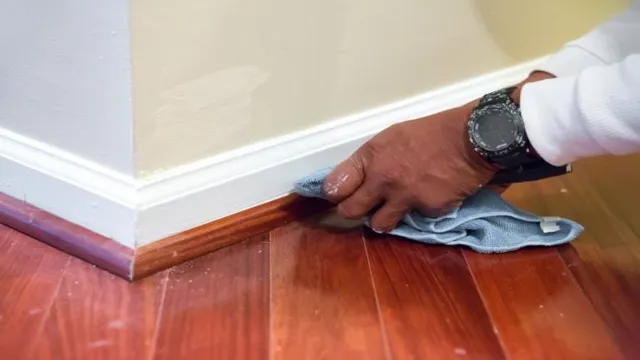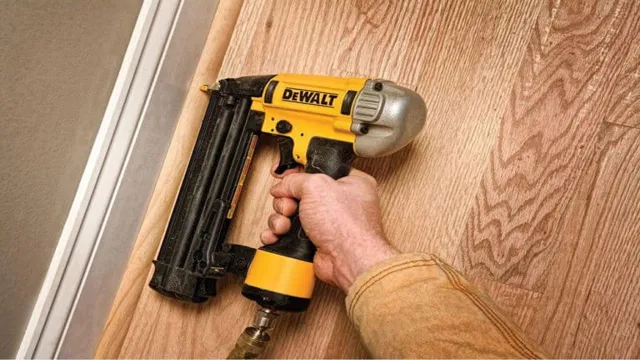Have you ever completed a flooring project only to realize that you forgot to install shoe molding? Or maybe you’ve been putting off the task because you’re not entirely sure what size nails to use. Well, you’re not alone! Installing shoe molding can be a daunting task, especially if you’re uncertain about the technical aspects. But fear not – we’ve got your back.
In this blog post, we’ll answer the burning question: “What size nails should you use for shoe molding?” So, sit back, grab a cup of coffee, and let’s dive in!
Understanding Shoe Molding
When it comes to installing shoe molding, one important factor to consider is the size of the nails needed. The appropriate size will depend on the thickness of the molding and the material it will be attached to. For standard shoe molding, 1 1/4 inch or 1 1/2 inch finishing nails are usually sufficient.
However, if the molding is thicker or made from a harder material, longer nails or even brad nails may be necessary. It’s important to choose the right size to ensure the molding is secure and won’t come loose over time. Additionally, using a nail gun can make the installation process much faster and easier, especially if you have a large area to cover.
Overall, understanding the proper size and type of nails for shoe molding is an important step in ensuring a successful and long-lasting installation.
What is Shoe Molding?
Shoe molding is a small strip of trim that is installed along the bottom of baseboards and connects to the flooring. It is called shoe molding because it resembles a small shoe. Its purpose is to cover the gap between the baseboards and the flooring, and to protect the walls from scuff marks made by shoes and cleaning equipment.
Shoe molding is typically made of wood, plastic or composite materials, and comes in a variety of colors and styles to match the flooring and baseboards. While it is not necessary for the functionality of the room, it can add a decorative element to the overall design and make your home look more finished. In summary, shoe molding is a small yet essential component in the world of home design and renovation.

Why is Shoe Molding Important?
Shoe molding is a crucial part of any flooring project. This small strip of molding is installed at the base of walls around a room, covering the gap between the flooring and the wall. It may seem like a minor aspect, but shoe molding serves an important purpose.
Without it, the baseboard would not sit flush against the flooring, leaving unsightly gaps and exposing the wall to potential damage. Shoe molding also provides a finished look to your flooring, making it look seamless and professionally installed. Additionally, it can offer a protective barrier against moisture, dust, and debris.
When selecting shoe molding, it is important to consider the color and style to make sure it complements your flooring and overall decor. Overall, shoe molding is a key element in achieving a polished and cohesive look for your floors.
Selecting the Right Nail Size
If you’re wondering what size nails are appropriate for shoe molding, it’s important to consider the thickness of the molding and the material it’s made from. Generally, 2-inch or 2 1/2-inch finishing nails should work well for shoe molding since it’s a relatively thin trim. However, if the molding is made from a harder material or is particularly thick, a longer nail may be necessary to ensure a secure hold.
It’s always a good idea to do a test fit before nailing anything into place. Plus, using a nail gun can save time and ensure a consistent depth for each nail. Remember, choosing the right nail size is crucial for securing your shoe molding and ensuring a clean, professional finish.
Consider the Thickness of Your Shoe Molding
When it comes to selecting the right nail size for your shoe molding, there are a few factors to consider. One important factor is the thickness of your shoe molding. If your shoe molding is thicker, you’ll want to use a longer nail to ensure a secure fit.
However, if your shoe molding is thinner, a shorter nail will work just fine. Another factor to consider is the material of your shoe molding. If you’re working with a particularly dense or hard material, you’ll need a thicker or stronger nail to penetrate it.
On the other hand, if your shoe molding is made of a softer material, a thinner nail may be all that’s needed. Ultimately, the goal is to select a nail that will provide a secure hold without damaging the shoe molding itself. By taking the time to consider these factors, you can ensure that your shoe molding installation is successful and long-lasting.
Choosing the Right Nail Length
When it comes to selecting the right nail size, there are a few key things to keep in mind. First, you’ll want to consider the thickness of the material you’ll be nailing into. For thinner materials like trim or molding, shorter nails are often the best option.
On the other hand, thicker materials like framing or decking may require longer nails for optimal holding strength. Another important factor to consider is the type of nail you’re using. Different nail types have different shank and head shapes, which can affect their ability to hold securely.
For example, a brad nail has a very small head and fine shank, which makes it ideal for delicate woodworking projects, but not suitable for heavy-duty construction. Ultimately, it’s important to choose the right nail size based on the specific task at hand, taking into account the material being used, the type of nail, and other factors like weight-bearing requirements.
The Benefits of Using the Correct Nail Size
When it comes to selecting the right nail size, the benefits are significant. Using the correct size can make all the difference in the success of your project. A nail that is too small may not hold the weight or pressure required, while a nail that is too large can cause splits and cracks in the material.
The right nail size ensures a secure and stable connection without damaging the material. It also ensures that the nail will not protrude from the other side of the material, which can be dangerous and unsightly. By considering the materials you are working with and the weight or pressure they will endure, choosing the appropriate nail size can be the difference between a project that lasts for years, and one that requires constant repair.
So next time you are using nails, remember to choose the right size for the job, and avoid the pitfalls of using the wrong ones.
Common Nail Sizes for Shoe Molding
If you’re wondering what size nails to use for shoe molding, it depends on the thickness of your molding and the surface you’re nailing into. Typically, the most common nail sizes for shoe molding are 1 ¼ inch or 1 ½ inch finishing nails. These nails are thin and have a small head, which makes them perfect for securing shoe molding without the nail head being visible.
However, if you’re nailing into hardwood, you may need longer nails to ensure a secure hold. It’s important to choose the right size nail to prevent splitting or cracking the molding. Before you start nailing, make sure to pre-drill holes in the molding to prevent any damage.
By using the right size nails, you can ensure a professional finish to your shoe molding installation.
16-Gauge Nails
If you’re looking to install shoe molding, choosing the right size nails is crucial for a secure and lasting installation. One of the most common nail sizes for shoe molding is 16-gauge nails. These nails are a great choice for shoe molding because they are strong enough to hold the molding in place but won’t split the wood.
Plus, they leave a smaller hole than larger nail sizes, which means less visible damage to the molding. When using 16-gauge nails, it’s important to make sure you’re using the correct length. Generally, you’ll want to use nails that are at least 1 1/4 inches long to ensure they penetrate the molding and the wall.
With the right nail size and length, your shoe molding installation will be secure and look great for years to come.
18-Gauge Nails
When it comes to shoe molding, the most common nail sizes are 16- or 18-gauge. However, 18-gauge nails are often preferred due to their smaller size and less noticeable appearance. These nails are also strong and durable enough to hold shoe molding securely in place, even with daily wear and tear.
Additionally, 18-gauge nails are less likely to split the molding or damage the wall when being nailed in. Overall, 18-gauge nails are a great choice for securing shoe molding and achieving a professional, polished look.
Conclusion
At the end of the day, the question of what size nails to use for shoe molding is not so much a matter of size as it is a matter of precision and attention to detail. Just like a skilled craftsman carefully selects the right tool for the job, a savvy DIY enthusiast should take the time to consider the nuances of their materials and environment to choose the best fastening option. So, whether you opt for a larger or smaller nail, remember to always measure twice, cut once, and take pride in your finished product!”
FAQs
What size nails should I use for shoe molding?
The recommended nail size for shoe molding is 1 1/4 inches in length.
Can I use finishing nails for shoe molding?
Yes, finishing nails that are 1 1/4 inches in length are suitable for shoe molding.
What type of nail gun should I use for installing shoe molding?
A finish nailer with a 1 1/4 inch nail capacity is recommended for installing shoe molding.
Can I use a hammer to install shoe molding?
Yes, you can use a hammer and finishing nails to install shoe molding, but a nail gun will result in a quicker and neater finish.
What is the best material for shoe molding nails?
Stainless steel nails are the best choice for shoe molding as they resist rust and corrosion.
How far apart should I space the nails when installing shoe molding?
Space the nails approximately every 16 inches along the length of the shoe molding for secure installation.
Can I use glue instead of nails for installing shoe molding?
While glue can be used, nails provide a stronger and more secure installation for shoe molding.






